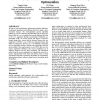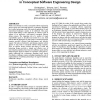GECCO
2008
Springer
14 years 8 months ago
2008
Springer
In this paper we describe an improvement of an entropy-based diversity preservation approach for evolutionary algorithms. This approach exploits the information contained not only...
GECCO
2008
Springer
14 years 8 months ago
2008
Springer
We study the minimum s-t-cut problem in graphs with costs on the edges in the context of evolutionary algorithms. Minimum cut problems belong to the class of basic network optimiz...
GECCO
2008
Springer
14 years 8 months ago
2008
Springer
In order to solve nonstationary optimization problems efficiently, evolutionary algorithms need sufficient diversity to adapt to environmental changes. The dual-population genetic...
GECCO
2008
Springer
14 years 8 months ago
2008
Springer
This paper compares three common evolutionary algorithms and our modified GA, a Distributed Adaptive Genetic Algorithm (DAGA). The optimal approach is sought to adapt, in near rea...
GECCO
2008
Springer
14 years 8 months ago
2008
Springer
Quantum-inspired evolutionary algorithms (QIEAs), as a subset of evolutionary computation, are based on the principles of quantum computing such as quantum bits and quantum superp...
GECCO
2008
Springer
14 years 8 months ago
2008
Springer
This paper deals with the problem of comparing and testing evolutionary algorithms, that is, the benchmarking problem, from an analysis point of view. A practical study of the app...
GECCO
2008
Springer
14 years 8 months ago
2008
Springer
In evolutionary algorithms, the typical post-processing phase involves selection of the best-of-run individual, which becomes the final outcome of the evolutionary run. Trivial f...
GECCO
2008
Springer
14 years 8 months ago
2008
Springer
While recent attempts to search a conceptual software engineering design search space with multi-objective evolutionary algorithms have yielded promising results, the practical ap...
GECCO
2008
Springer
14 years 8 months ago
2008
Springer
This paper presents a path planner for Unmanned Air Vehicles (UAVs) based on Evolutionary Algorithms (EA) that can be used in realistic risky scenarios. The path returned by the a...
CEC
2010
IEEE
14 years 8 months ago
2010
IEEE
Abstract-- Recently, the research on quantum-inspired evolutionary algorithms (QEA) has attracted some attention in the area of evolutionary computation. QEA use a probabilistic re...






